FISHWATCH 2022 MONTHLY REPORT
August 2022
by Edward Kikumoto
COVID19 STATUS – The Big Bend Pool is open to the public this year until further notice to the contrary.
Compliance with CDC guidelines is recommended, especially for those who are unvaccinated and have underlying health concerns.
The FishWatch Caretaker is “social distancing,” and is happy to speak with you…just at a distance.
THE FISHWATCH MISSION
1) Deter poaching of the steelhead in the Big Bend Pool.
2) Keep human disturbance of the steelhead in the Pool to a minimum.
3) Educate the public about the Pool and its wild summer steelhead.
DISCLAIMER
The views and opinions in this report are strictly my own, and do not reflect the views and opinions of the U.S. Forest Service (USFS), the Oregon Department of Fish & Wildlife (ODFW), or The North Umpqua Foundation (TNUF).
Greetings from the Big Bend Pool,
OVERVIEW
I have not observed any illegal, unlawful or unacceptable behavior at the Pool during this month.
There were 190 visitors to the Pool on the days I was present during daytime at the Pool.
At the beginning of the month I estimated 120 wild summer steelhead in the Big Bend Pool, with an additional 70-80 steelhead in another pool, downstream.
At the end of the month I estimated 240-250 steelhead in the Big Bend Pool, with 80 steelhead downstream. In aggregate I was seeing 320 to 330 steelhead – an unusually high number given the low returns reported by ODFW. (See ODFW’s News Release below.)
ODFW’s preliminary numbers from August 22 are:
-
350 steelhead in the Steamboat Creek Basin.
-
200+ steelhead in the Big Bend Pool.
-
100 steelhead in a pool below the Big Bend Pool.
ODFW’s August 18 News Release reported 1,049 wild summer steelhead crossed Winchester Dam by July 19, along with 2,293 hatchery summer steelhead. The wild summer steelhead count is low for this time of year, and the hatchery count is average.
August 18, 2022
Roseburg, Ore – Numbers of wild summer steelhead returning to the North Umpqua River are showing improvement.
As of July 19, 1,094 wild summer steelhead crossed Winchester Dam in the North Umpqua River. Which is an improvement over 2021 when a total of just 450 wild fish returned. Although returns remain low average for this time of year, this is an encouraging sign.
Returns have been closely monitored this summer via a 24/7 count of all fish passing the video counting station at Winchester Dam. Current analysis projects this year’s run to be above the critical threshold of 1,200 wild summer steelhead returning by Dec. 1.
Fishery managers expected higher returns this year based on improving ocean conditions.
“We are seeing indications of improved ocean conditions, and we expect this uptick in summer steelhead returns to continue in the near future along with other salmon and steelhead runs,” said Evan Leonetti, Assistant District Fish Biologist.
Thre have also been good numbers of hatchery summer steelhead in the North Umpqua River. Through July 19, 2,293 hatchery fish moved through the Winchester Dam fish ladder. This is closer to the average number of hatchery fish for this time of year and is providing for a good fishery that will continue into the fall.
Even with cooler nights and water temperatures as we move towards fall, biologists encourage anglers to follow good catch-and-release techniques for wild fish. Other recreationists are encouraged to avoid areas where wild summer steelhead may be holding such as deeper, cooler pools in the North Umpqua River system.
The flow through the Big Bend Pool continued to drop through August from 70.8 cubic feet per second (cfs) at the USGS Canton Creek Campground Gage (combined flows from Canton Creek and Steamboat Creek) to 34.3 cfs at the end of the month. The lowering flow is typical for this time of year. As of the writing of this report in early September the water level continues to drop very slowly.
The difference in height between winter high and summer low is about 3 feet.
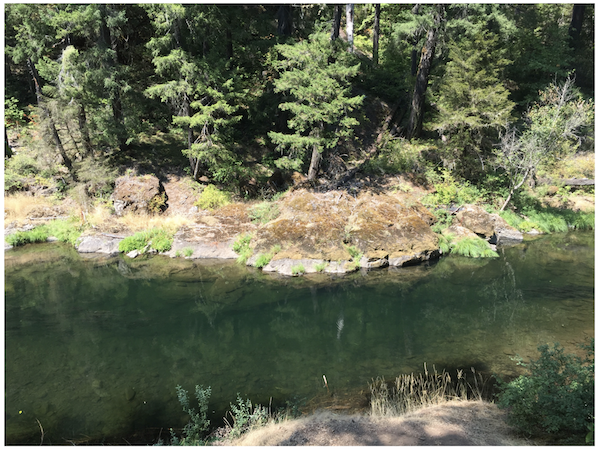
Summer low. Note the yellow moss line above the exposed rock, which is the high flow mark.
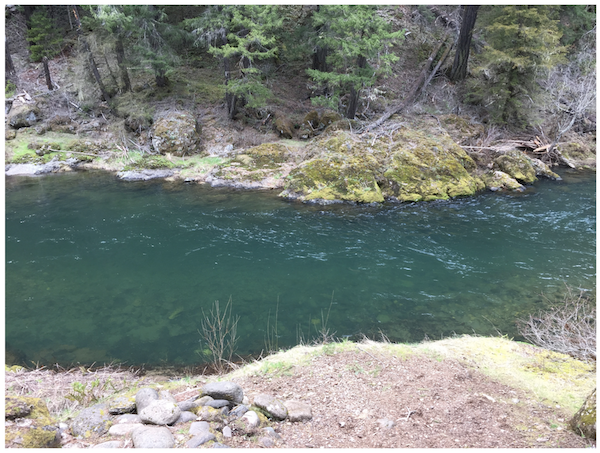
Normal winter flow, about 3 feet higher than summer low.
The weather is beginning to moderate in August particularly with cooler temperatures in the evening although there are still occasional hot days.
There were a couple of days where lightning strikes threatened to cause wildfires, but they were quickly suppressed. There was one brief early morning shower at this time, which was all the rain we received in August.
It seems that this fire season will be short because it started late due to greater than normal rainfall this spring and early summer. Wildfire season should end in late September with cooler temperatures and the first Fall rains. Thankfully, we haven’t seen any large catastrophic fires in the Umpqua National Forest.
Another indicator of coming Fall is the colder water temperatures in and around the Big Bend Pool, which are beginning to drop back into the steelhead’s comfort zone (under 64oF), and the steelhead know it – they are more spread out in the Pool and holding much nearer to the surface, and not concentrated in narrow lanes of cold water, which also tend to be deeper in the water column.
WILDLIFE
The otters (mom and two pups) left last month, and now the beavers have gone as well. In mid-July I saw an adult beaver and one kit (baby beaver). At the end of July I finally saw two kits, but only one adult. In early August I would occasionally see the adult beaver with one kit, but never with both kits at the same time. On August 16, I saw the adult beaver returning to its den with willow branches in tow. It would be the last time I saw the beavers in the Pool. The fact that both the otters and beavers leave the area of the Pool during the summer is normal.
I keep saying “adult beaver” because I don’t know if it’s a male or female. There were originally two adults in the pool, and they appeared to be building a nest. One was markedly bigger and darker than the other. Not only were they collecting nesting materials but also large quantities of willow branches with leaves. It was interesting to see that the larger beaver was doing most of the heavy lifting – bringing in large bare branches and tree limbs to the nest, while the smaller beaver concentrated on leafy willows, and lots of them. My thought, watching all this activity, was that they were nesting to make babies. The smaller adult floated at the bottom of the Pool one evening and ate all the leaves off of a willow branch it had collected. Then one day the bigger beaver was gone. I’ve been told that beavers generally mate for life, so the fact that one was gone is a bit disturbing. It was after the larger beaver was gone that I saw a kit for the first time, which makes me think the “adult beaver” I was seeing was the female.
A group [or family] of kingfishers have come to the Pool this month.
I’ve also been seeing more small wildlife roadside as I make my trips back and forth from home. Along with the occasional blacktail deer, I’ve been seeing more foxes, or maybe the same fox or family of foxes in the same general area I’m driving through. I saw a raccoon halfway back to the Pool, which for some reason I associate more with places where folks are, and not deep in the woods.
On my walks up the road from the pool I’ve seen ruffed grouse, chipmunks, gray squirrels, and a medium size fox watching me from a distance before disappearing into the woods. No black bears or mountain lions…yet. At least not down near the road. It very well may be that there is too much road traffic and too many recreational vehicle campers along the road. The bears and mountain lions are here, just not nearby.
But what really got my attention this month was what I saw as I was taking the water temperature at Big Bend Creek on August 23 and 27. Right where I take the water temperature was a fully-grown, finely articulated orange crayfish. It was the finest specimen of a crayfish I’ve ever seen, and so perfect that it didn’t look real, about 4-inches long. Four days later, lo and behold, in the same spot, another gift from Mother Nature, an 8 to 9- inches salamander resting on a streamside rock at my feet.
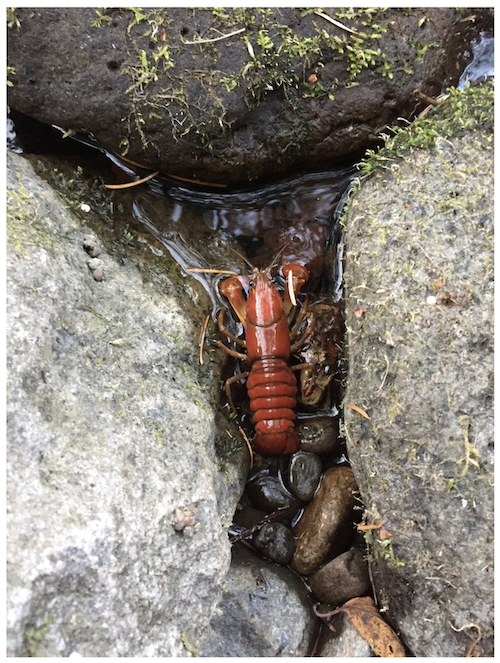
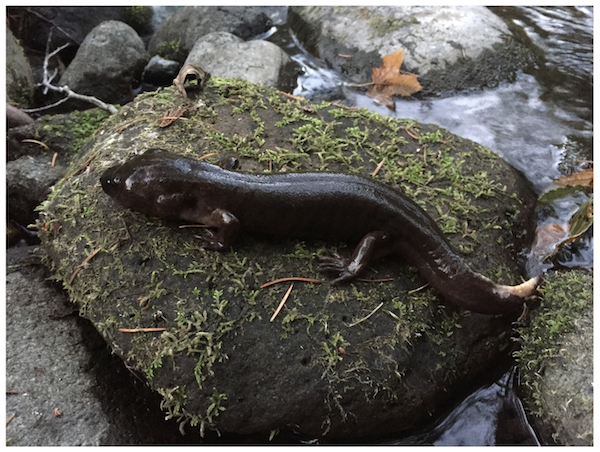
INFRASTRUCTURE
The Airstream is working as I need it to.
I’m working on connecting the Honda EU2200i directly to the Airstream’s low-pressure propane system. I’ll be tapping into the line that feeds the water heater, which isn’t being used. I’ve ordered the hose and connections to do this. Sourcing propane from the Airstream will eliminate the need to use 20-pound portable tanks, which need to be refilled regularly.
The weather is cooling down so the refrigerator is able to keep up and is back to normal cooling temperatures.
The sun is lower on the horizon as summer wanes so the solar panels are not charging as well as earlier in the summer, which means that the batteries require more generator time to charge sufficiently – an additional hour every evening.
The portable toilets once again have had moderate use this month. It seems much quieter up here overall than what I saw and experienced in 2018. September and October should see more use from hunters – bow hunting for deer and elk in September, and general gun season for deer in October. The upland game bird season also starts in September.
Water temperature readings:
High air (AIR) temperature is around 1PM.
Water temperature taken at dusk (at the moment around 7:30 PM).
The Big Bend Creek (BBC) water temperature is taken just above its confluence with Steamboat Creek.
The Steamboat Creek (SC) temperature is taken above Big Bend Creek.
The Big Bend Pool (BBP) water temperature is taken at the bottom of the Pool where it flows out mixed (Steamboat Creek and Big Bend Creek).
Keep in mind that the water flowing through the Pool is striated both vertically and horizontally (the water from Steamboat Creek and Big Bend Creek don’t completely mix until they get to the back of the Pool), so that the steelhead find the coldest water flows to hold in. Generally speaking, the colder water will be beneath the warmer water.
Water temperature readings are being taken on a ThermoWorks ThermaCheck Plus digital thermometer.
August 3 saw similar high water temperatures as recorded on July 31.
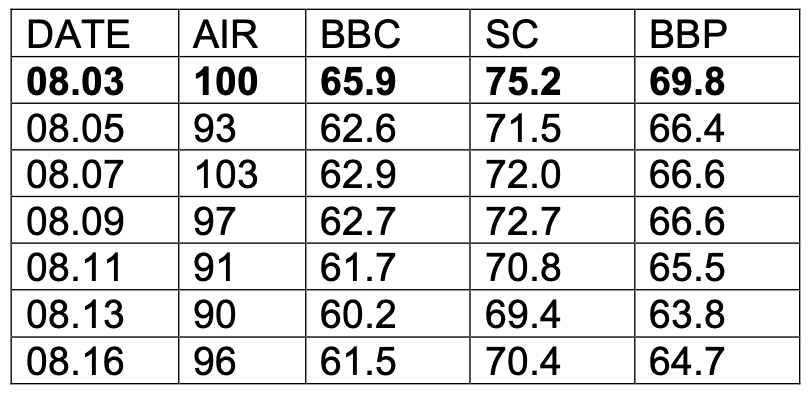
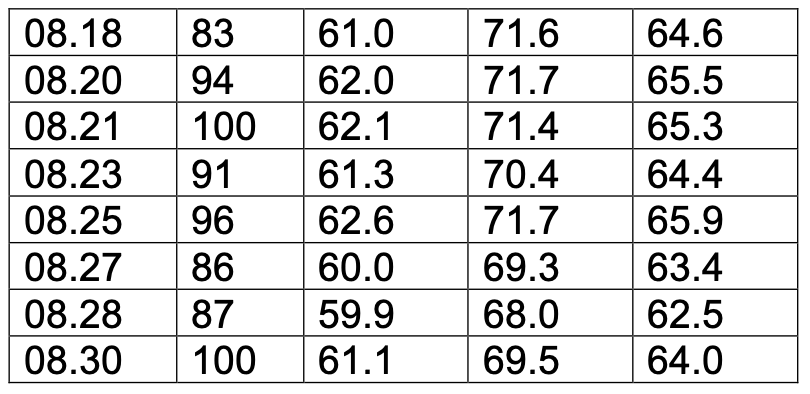
USGS Water Flow Gage at Canton Creek Campground
(Canton Creek & Steamboat Creek combined flow, Cubic Feet Per Second [CFS])
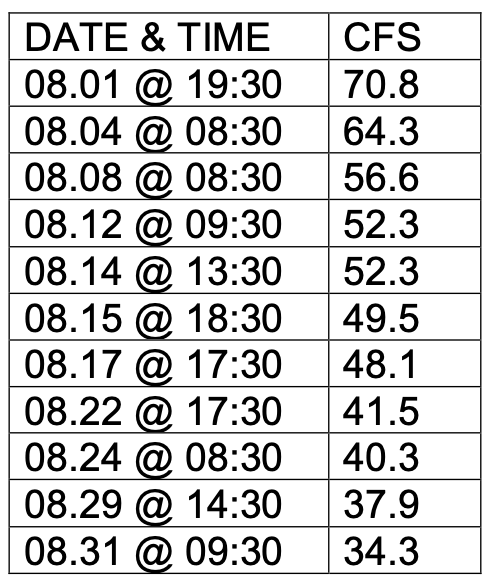
BIG BEND POOL FIELD NOTES
How steelhead behavior is affected by environmental conditions…
There is a difference in behavior this year from what I thought was typical and predictable behavior of steelhead in the Big Bend Pool. I think the difference is the wet spring in contrast to the previous 10-years of drought.
A little context…
Keep in mind that any year’s wild summer steelhead (with the exception of that rare return-spawner) has only been in the Pool once before as a smolt (baby, maybe 2-inches long), and only momentarily at that, on its way to the big river (North Umpqua) to get a little bigger before eventually heading out to sea as a 2-year-old (maybe 6-inches) – to live and grow for three years. Five years after it is born, it will return as a 24 to 28-inches adult weighing 5 to 7-pounds (on average).
Which is to say that each year we are seeing a new cohort of first time spawners in the Pool. But despite the fact that I was seeing a new cohort in the Pool every year their behavior has been so similar that it appeared to be predictable. So predictable that I thought it must somehow be encoded in their genes and not just a behavioral response to circumstances,
After this year’s wet spring, it has become apparent that the “predictable” behavior I was seeing was a result of the environmental conditions due to 10-years of drought – low flows beginning in the winter becoming even lower through the summer, warmer than normal water temperatures, and negligible amounts of rain until late September or early October.
So, “not just” a behavioral response to circumstances, but a highly developed sensitivity to environmental signals, which “tells” them that the Big Bend Pool is where they need to be.
Nevertheless, they can be “caught out,” and extreme environmental events can kill them. Last year, a June heat wave caught most of the year’s wild summer steelhead below Winchester Dam in the Umpqua River and North Umpqua River where water temperatures rose into the high 70s and 80s creating a thermal barrier that trapped the steelhead. It killed them. 450 steelhead were able to cross Winchester Dam that year, and only 55 wild summer steelhead made it to the Big Bend Pool (as compared to 1851 wild summer steelhead crossing Winchester Dam, and 250 wild summer steelhead in the Big Bend Pool in 2018). In 2019 major flooding in the North Umpqua watershed in April killed that year’s baby steelhead (alevins) that had just hatched during the February/March spawning period. The extraordinary water volume scoured the spawning gravels from the bottom of creeks, killing the entire year’s hatch. Five years from 2019 and 2021 we can expect to see very low returns of wild summer steelhead to the Big Bend Pool.
Drought and the Big Bend Pool.
In drought years I expect to see steelhead in the Big Bend Pool as early as mid-May. The steelhead that are coming into Steamboat Creek don’t “hang around” in other pools, but relatively quickly make their way to the Big Bend Pool. If they “hang out” in a pool just downstream, it’s only for a day or two before they make their way to the Pool. Although the water flow is low, they can still cross Little Falls, and the water is cold and oxygenated (the warmer the water the less oxygen it can retain). Late summer low flows and high water temperatures stop the migration of steelhead out of the North Umpqua River into Steamboat Creek until water levels rise again with rain [hopefully] in late September.
Under drought conditions (low flows but relatively cold water temperatures), almost all of the steelhead would hold at the back of the Pool. During heat- waves when the water temperatures warmed up into the high 60s, they would move up to the Dropoff, where the colder water from Big Bend Creek flows into the Pool. But when the water temperatures dropped back down below 64oF, the steelhead would return to the back of the Pool.
What I am seeing in the Big Bend Pool, in drought years, are the wild summer steelhead that make it over Little Falls in the spring and early summer, before the water level drops so low that they can no longer get over it. Those that didn’t make it in time wait in the North Umpqua River for rain. Sometimes it rains heavily in the middle of summer and the steelhead can make it over Little Falls. In drought years that is not as likely. There is a wild summer steelhead that comes into the North Umpqua River in late summer. Some of these “late summers” will turn into Steamboat Creek. It’s not likely that I’ll see a noticeable increase in numbers of steelhead in the Big Bend Pool.
This year – acting different.
This hasn’t been the case this year, I think primarily because we had a very wet spring and a big late season snow pack, which resulted in high flows and colder water temperatures into early summer. We continued to feel the impact of spring runoff into mid-summer.
For a start the high flows stopped the steelhead from getting over Little Falls until the end of June. The first steelhead appeared in the Big Bend Pool on July 1.
A large number of steelhead (60 to 100, at times) decided they didn’t need to be in the Big Bend Pool, but rather preferred to “hang out” downstream – in a pool, that in the past, they stopped in for a day or two, before moving up to the Big Bend Pool. A large number of steelhead have been holding in this pool all summer despite the fact that the water temperatures in that location were up to 66 to 67oF during a number of summer heat-waves, albeit of short duration.
The steelhead in the Big Bend Pool were also acting differently from in the past. Early on, due to continued high flows, they were holding on the bottom of the pool where the flow was slowest due to friction with the bottom. This is normal in higher flows (above 50 cubic-feet-per-second at the USGS Canton Creek Campground Gage).
Keep in mind that the pool isn’t particularly deep – 10 feet deep at low summer flows and not more than 13 feet deep in high winter flows. They will also seek the bottom if that is where the coldest water is.
However, as the water volume and speed slowly dropped, rather than drop back into the tailout (where I would expect them to be), most of the steelhead moved up to the head of the Pool, where the deep part started (The DropOff). And there they stayed, initially most of the steelhead, and later, more than half of the steelhead in the Pool.
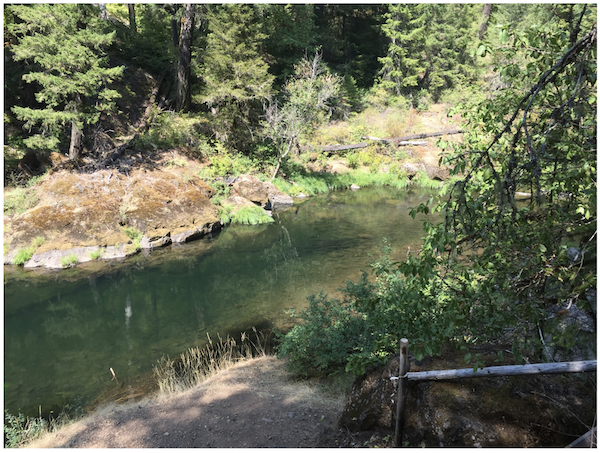
Steelhead in the DropOff. Typical behavior this year.

Steelhead holding in the lower half of the Pool. The Tailout is in the upper left of the frame. The steelhead are strung out into the Tailout.
Even when the water temperatures in the Pool dropped below 64oF the steelhead decided to stay at the DropOff and behaved as if the water was still warm, even moving up onto the shallow shelf above the DropOff in the mid-afternoon. I have never seen the steelhead do this day-in and day-out throughout the summer.
This behavior is surprising to me because the steelhead are so tightly packed in the DropOff and so exposed on the shelf above it. The DropOff is relatively shallow, it being the beginning of the pool, but the shelf (riffle) is only 1 to 2-feet deep in summer low flow conditions. And yet, I have never seen an eagle or osprey attack the steelhead holding there.
Speculating about what happens at Little Falls.
The reason why the steelhead can’t get over Little Falls in high water is because of the hydrology of the pool beneath the falls. The steelhead need to get a running start to jump high enough to clear the falls. Little Falls isn’t particularly high, but not having enough “running room” to get up to speed makes even a low falls impossible to get over. Which is to say that they need solid water (not bubbles) to be able to swim. It also helps if there is solid water coming over the falls, which steelhead can actually swim up, as unbelievable as that may be.
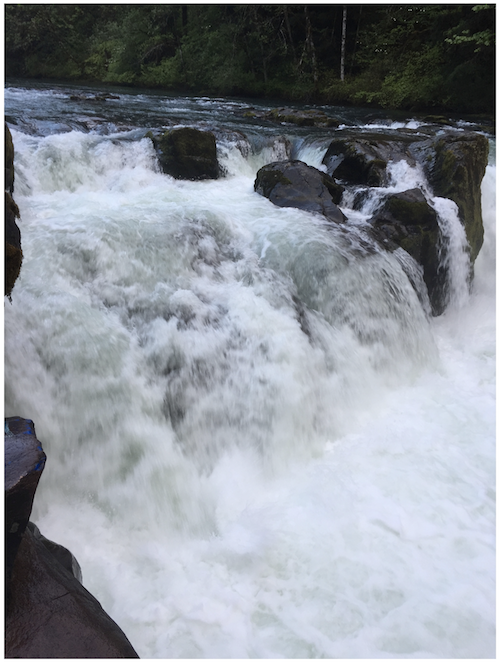
Little Falls on May 19 of this year. The USGS Canton Creek Campground Gage was at 947 cfs.
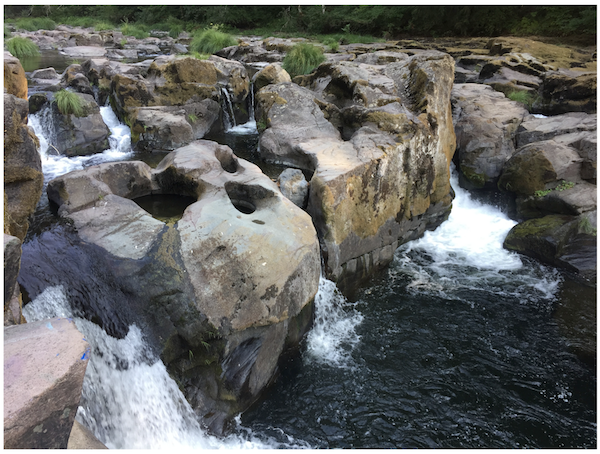
The same spot at late summer low flows. The Gage at 27.8 cfs. Note the waterfall in the lower left corner of the frame. This is the only way over the falls. But only if a steelhead can make the jump.
On the other hand in late summer low water conditions, the water in the lower pool may be so low that the steelhead can’t jump high enough to clear the rocks and reach the small pools nestled amongst the rock structure that makes up the falls. (See the picture, below.) So the times when the steelhead can get over Little Falls is limited to early summer and in the late summer into Fall, before the flows get too big, again. It all depends on when it rains and how much it rains.
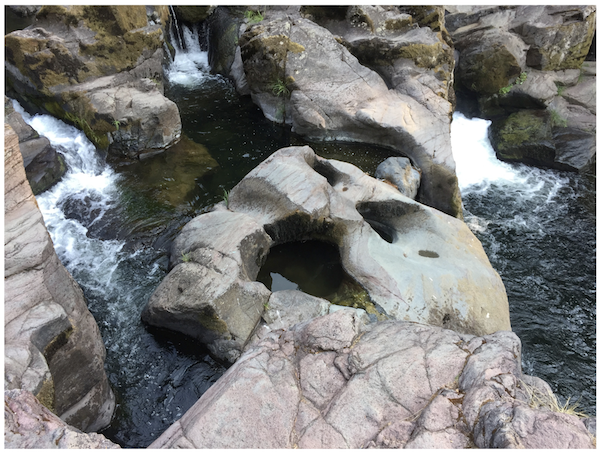
The top of Little Falls at late summer low flows – the channel in the lower left of the frame is the top of the waterfall in the previous picture.

A wild summer steelhead trying to get over Little Falls on November 14, 2021. The Gage was at 439 cfs.
This year, with the spring run-off lasting into July, more steelhead were able to get over Little Falls and move up Steamboat Creek, which may be why I’m seeing more steelhead in the Pool than expected, despite the lower than normal counts over Winchester Dam reported by ODFW.
END OF AUGUST 2022 REPORT
Respectfully submitted,
Ed Kikumoto
FishWatch 2022 Caretaker
